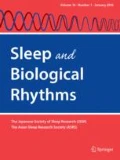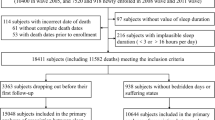Abstract
There is apt evidence in favor of a significant association between sleep and mortality. So far, most studies examine sleep problems using comprehensive, time-consuming tools and questions. In this study, we investigated the ability of four simple “yes” or “no” answered questions (i.e. easiness to fall asleep, restful upon awakening, sleep satisfaction and presence of insomnia) to predict 12-year all-cause and cardiovascular mortality in a rural population of 1519 citizens. The sample consisted of 652 males and 867 females, with a mean age of 56.9 years old (range 15–102 years old). Age, gender, education, smoking, body mass index and health status were used as confounders in the Cox proportional hazard models. 293 (19.3%) deaths were recorded. After adjusting for confounders, difficulty to fall asleep was significantly related to an increased risk of cardiovascular death in smokers (aHR 3.71, 95% CI 1.01–13.62). Male individuals, not feeling restful upon awakening were at a significantly increased risk of all-cause (aHR 2.08, 95% CI 1.33–3.24) and cardiovascular mortality (aHR 6.24, 95% CI 1.90–20.49), in the latter case only if they were non-smokers. Smokers, not satisfied with their sleep, were at a significantly increased risk of cardiovascular death (aHR 5.44, 95% CI 1.73–17.09). The presence of insomnia significantly increased the risk of all-cause mortality (aHR 8.10, 95% CI 1.66–39.57) in smokers of basic education and cardiovascular mortality (aHR 26.68 95% CI 4.78–148.49) in smokers. In conclusion, simple sleep questions can predict mortality, at least in rural populations. Future studies should expand these results to other populations.
Similar content being viewed by others
References
Grandner MA. Sleep, health, and society. Sleep Med Clin. 2017;12(1):1–22.
da Silva AA, de Mello RG, Schaan CW, Fuchs FD, Redline S, Fuchs SC. Sleep duration and mortality in the elderly: a systematic review with meta-analysis. BMJ Open. 2016;6(2):e008119.
Shen X, Wu Y, Zhang D. Nighttime sleep duration, 24-hour sleep duration and risk of all-cause mortality among adults: a meta-analysis of prospective cohort studies. Sci Rep. 2016;6:21480.
Ensrud KE, Blackwell TL, Ancoli-Israel S, et al. Sleep disturbances and risk of frailty and mortality in older men. Sleep Med. 2012;13(10):1217–25.
Mallon L, Broman JE, Hetta J. Sleep complaints predict coronary artery disease mortality in males: a 12-year follow-up study of a middle-aged Swedish population. J Intern Med. 2002;251(3):207–16.
Rod NH, Vahtera J, Westerlund H, et al. Sleep disturbances and cause-specific mortality: results from the GAZEL cohort study. Am J Epidemiol. 2011;173(3):300–9.
Rod NH, Kumari M, Lange T, Kivimäki M, Shipley M, Ferrie J. The joint effect of sleep duration and disturbed sleep on cause-specific mortality: results from the Whitehall II cohort study. PLoS One. 2014;9(4):e91965.
Gómez-Olivé FX, Thorogood M, Kandala NB, et al. Sleep problems and mortality in rural South Africa: novel evidence from a low-resource setting. Sleep Med. 2014;15(1):56–63.
Hamer M, Batty GD, Kivimaki M. Sleep loss due to worry and future risk of cardiovascular disease and all-cause mortality: the Scottish Health Survey. Eur J Prev Cardiol. 2012;19(6):1437–43.
Howrey BT, Peek MK, Raji MA, Ray LA, Ottenbacher KJ. Self-reported sleep characteristics and mortality in older adults of mexican origin: results from the Hispanic established population for the epidemiologic study of the elderly. J Am Geriatr Soc. 2012;60(10):1906–11.
Kojima M, Wakai K, Kawamura T, et al. Sleep patterns and total mortality: a 12-year follow-up study in Japan. J Epidemiol. 2000;10(2):87–93.
Qiu L, Sautter J, Liu Y, Gu D. Age and gender differences in linkages of sleep with subsequent mortality and health among very old Chinese. Sleep Med. 2011;12(10):1008–17.
Hublin C, Partinen M, Koskenvuo M, Kaprio J. Heritability and mortality risk of insomnia-related symptoms: a genetic epidemiologic study in a population-based twin cohort. Sleep. 2011;34(7):957–64.
Rockwood K, Davis HS, Merry HR, MacKnight C, McDowell I. Sleep disturbances and mortality: results from the Canadian Study of Health and Aging. J Am Geriatr Soc. 2001;49(5):639–41.
Althuis MD, Fredman L, Langenberg PW, Magaziner J. The relationship between insomnia and mortality among community-dwelling older women. J Am Geriatr Soc. 1998;46(10):1270–3.
Phillips B, Mannino DM. Does insomnia kill? Sleep. 2005;28(8):965–71.
Sivertsen B, Pallesen S, Glozier N, et al. Midlife insomnia and subsequent mortality: the Hordaland health study. BMC Public Health. 2014;14:720.
Darviri C, Artemiadis A, Tigani X, Darvyri P, Gnardellis C. Religiosity as a predictor of mortality: a retrospective cohort study in 1519 rural citizens in Greece. Psychol Health. 2016;31(9):1080–90.
Idler EL, Benyamini Y. Self-rated health and mortality: a review of twenty-seven community studies. J Health Soc Behav. 1997;38(1):21–37.
Irwin MR. Why sleep is important for health: a psychoneuroimmunology perspective. Annu Rev Psychol. 2015;66:143–72.
McNamara JP, Wang J, Holiday DB, et al. Sleep disturbances associated with cigarette smoking. Psychol Health Med. 2014;19(4):410–9.
Krishnan V, Dixon-Williams S, Thornton JD. Where there is smoke… there is sleep apnea: exploring the relationship between smoking and sleep apnea. Chest. 2014;146(6):1673–80.
Lavie L, Lavie P. Smoking interacts with sleep apnea to increase cardiovascular risk. Sleep Med. 2008;9(3):247–53.
Zhang J, Lam SP, Li SX, Li AM, Wing YK. The longitudinal course and impact of non-restorative sleep: a five-year community-based follow-up study. Sleep Med. 2012;13(6):570–6.
Wakasugi M, Kazama JJ, Narita I, et al. Association between combined lifestyle factors and non-restorative sleep in Japan: a cross-sectional study based on a Japanese health database. PLoS One. 2014;9(9):e108718.
Sivertsen B, Krokstad S, Øverland S, Mykletun A. The epidemiology of insomnia: associations with physical and mental health. The HUNT-2 study. J Psychosom Res. 2009;67(2):109–16.
Rhee CW, Kim JY, Park BJ, Li ZM, Ahn YO. Impact of individual and combined health behaviors on all causes of premature mortality among middle aged men in Korea: the Seoul Male Cohort Study. J Prev Med Public Health. 2012;45(1):14–20.
McEwen BS, Gianaros PJ. Central role of the brain in stress and adaptation: links to socioeconomic status, health, and disease. Ann N Y Acad Sci. 2010;1186:190–222.
Funding
The study received no funding.
Author information
Authors and Affiliations
Corresponding author
Ethics declarations
Ethical approval
All procedures performed in studies involving human participants were in accordance with the ethical standards of the institutional research committee and with the 1964 Helsinki declaration and its later amendments or comparable ethical standards. This article does not contain any studies with animals performed by any of the authors.
Informed consent
Informed consent was obtained from all individual participants included in the study.
Conflict of interest
On behalf of all authors, the corresponding author states that there is no conflict of interest.
Rights and permissions
About this article
Cite this article
Darviri, C., Artemiadis, A., Tigani, X. et al. Simple sleep questions can predict 12-year mortality in a rural population. Sleep Biol. Rhythms 16, 253–258 (2018). https://doi.org/10.1007/s41105-018-0147-9
Received:
Accepted:
Published:
Issue Date:
DOI: https://doi.org/10.1007/s41105-018-0147-9




